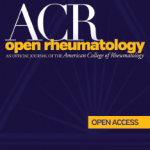 As ACR Open Rheumatology (ACROR) enters its fifth year, its founding editors in chief are looking back on the journal’s accomplishments and forward to ushering in a new era, beginning with a search for their successors.
As ACR Open Rheumatology (ACROR) enters its fifth year, its founding editors in chief are looking back on the journal’s accomplishments and forward to ushering in a new era, beginning with a search for their successors.
Patricia Katz, PhD, professor of medicine and health policy at the University of California, San Francisco (UCSF), and Edward H. Yelin, PhD, Edward A. Dickson Emeritus Professor of Medicine at UCSF, are nearing the end of their five-year term as co-editors. They point to major accomplishments since ACROR launched in March 2019, including the establishment of a journal club and inclusion of clinical images, as well as the release of ACROR’s first impact factor, expected in summer 2023.
“We got the seedling to sprout. The next editor or editors will keep tending and growing it,” says Dr. Katz.

Dr. Katz
“The new editor will have new ideas about expanding the journal, including its audience and the type of research that gets published,” says Dr. Yelin.
“We are looking forward to the next phase of ACROR and are excited to search for a new editor in chief,” says Amr Sawalha, MD, chair of the ACR Committee on Journal Publications, professor in, and chief of, the Division of Pediatric Rheumatology, holder of the Vincent Londino Endowed Chair in Pediatric Rheumatology and director of the Comprehensive Lupus Center of Excellence at the University of Pittsburgh School of Medicine and UPMC Children’s Hospital of Pittsburgh.

Dr. Sawalha
A search committee with reputable U.S. and international rheumatology investigators welcomes highly qualified candidates to apply. “Our goal is to recruit an editor in chief who would expand on the current success of ACROR and take it to a new level of excellence in basic, translational, and clinical research publications,” says Dr. Sawalha.
“There’s an opportunity for the new editor to take the journal into its next chapter,” adds Kimberly Murphy, senior director, ACR journals. “Editors are able to build their own editorial board. ACR is open-minded to applicants’ vision for the journal. It’s a way for someone to make a considerable mark on the ACR’s only open access offering.”

Ms. Murphy
Open Access
ACROR publishes high-quality, rigorously peer-reviewed articles on original investigations in all aspects of rheumatology research, including basic science, clinical science, epidemiology, health outcomes and education, as well as commentaries and reviews.
Since its March 2019 launch, ACROR, published by John Wiley & Sons on behalf of the ACR, has been a fully open-access journal. In other words, all content is accessible online for anyone to read in full. In contrast, the content of many journals, including Arthritis & Rheumatology (A&R) and Arthritis Care & Research (AC&R), is accessible only to ACR/ARP members or by subscription for a specific time, unless authors decide to purchase open access for their papers on an individual article basis, notes Dr. Katz. ACROR has no paid subscriptions. Any reader may excerpt figures or tables, and share, publish or reuse the content of ACROR articles for non-commercial purposes without obtaining copyright permission.
“We started from ground zero,” says Dr. Katz. She adds that ACROR has quickly gained acceptance in the field and drawn a substantial proportion of direct submissions. “We originally thought the journal would mainly publish papers transferred from the other ACR journals,” she says.
Transfer papers are high-quality research the other journals’ editors deem scientifically important but can’t fit in the limited space of a print publication. The review completed for a submission to A&R or AC&R can be used for ACROR submission, speeding the path to publication, says Ms. Murphy. To cover the cost of publishing and making articles freely available, authors or their institution are expected to pay an author processing charge (APC) fee.
ACROR now receives roughly the same number of directly submitted papers as transfers, Dr. Katz notes proudly.
Increasing Prestige
With the first impact factor coming this summer, Drs. Katz and Yelin expect ACROR to draw more submissions.
Many researchers depend upon publishing in high-impact factor journals for promotions and career development. Thus, many talented researchers don’t currently choose to publish in ACROR because they need each article to have an impact factor so the perceived significance and reach of their research can be evaluated, says Dr. Katz.

Dr. Yelin
Dr. Yelin noted, however, that ACROR offers other advantages. Because ACROR is an online-only journal, it can publish longer articles and include more backup materials than those in typical print publications. “That’s useful for authors who don’t want to relegate much of their work to the supplemental files,” Dr. Yelin points out.
Additionally, ACROR offers a full range of rheumatology research. For investigators, this means they can avoid being siloed. For clinicians, this means information about the state of the art in all types of rheumatology research, be it basic, translational, clinical or health services research, Dr. Yelin emphasizes.
Improvements for Readers
The journal will continue to provide a high-quality reader experience, enhanced by two major improvements over the past five years—inclusion of clinical images and a journal club.
Dr. Yelin and Ms. Murphy explain that clinical images provide valuable information to clinicians who may encounter patients whose conditions cause symptoms like those the images depict and who need to make correct diagnoses.
Print journals don’t have as much space for clinical images. “Because ACROR is [Web based], we can make many more images available to the rheumatology community,” Dr. Katz says.
ACROR’s monthly journal club for rheumatology fellows involves program directors who nominate fellows to critique selected articles and to publish a commentary in the peer-reviewed journal. Other fellows may comment on the critiques.
Dr. Katz credits ACROR Senior Editor Bruce N. Cronstein, MD, Dr. Paul Esserman Professor of Medicine, NYU Langone, New York, with the idea of starting the journal club, which she described as a two-fer for trainees, who get experience both writing and reading articles.
The club is also a way to interest young researchers in rheumatology, says Dr. Yelin.
A Trend Toward Open Access
As an entirely open access journal, ACROR started ahead of a major trend, Dr. Katz says. She and Dr. Yelin were co-editors of AC&R when it and other journals began publishing certain articles online before print, via open access. Now many funders require researchers publish the work they support via open access, she notes.
This trend is especially prevalent among government funders, Dr. Yelin and Ms. Murphy point out.
“Government funders want more immediate access. There’s also an equity issue for researchers in less developed countries,” adds Ms. Murphy. “The push for open access is a global movement.”
Strong editors, staying ahead of a trend and offering readers valuable improvements, have given ACROR a strong start. “Our mission during the next phase of ACROR is to clearly define the goals of the journal, increase its visibility and make it an attractive venue for authors to publish top research in rheumatology,” says Dr. Sawalha.
“The goal is to continue to publish all types of high-quality rheumatology research and expand options for publication in ACR-sponsored journals. I hope ACR Open Rheumatology will continue to grow,” Dr. Katz concludes.
Interested in becoming the next editor of ACROR? ACR/ARP members who are considering applying for the position should submit a nonbinding letter of intent by May 15, 2023, to Kimberly Murphy at [email protected]. For details, visit https://www.rheumatology.org/acr-open-rheumatology-journal.
Deborah Levenson is a writer and editor based in College Park, Md.

